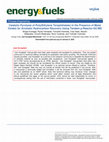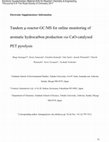Papers by Chuichi Watanabe
Chemical Engineering Journal
Journal of Analytical and Applied Pyrolysis, Nov 1, 2022

Journal of Analytical and Applied Pyrolysis, Jun 1, 2021
Evolved gas analysis-mass spectrometry (EGA-MS) has been used to characterize the effect of heati... more Evolved gas analysis-mass spectrometry (EGA-MS) has been used to characterize the effect of heating a material in an oxidative or non-oxidative environment. Measurements in an oxidative environment are usually done by using the mixture of air and helium (He) as the carrier gas; however, ionization efficiency of evolved gases in a mass detector (MSD) decreases in such an environment, resulting in a corresponding decrease in sensitivity. The drop in sensitivity can be reduced by diluting the air in the carrier gas with He after evolving gases from a sample and before the evolved gases flow to the MSD. This study reports on a simple modification of the gas inlet system so that experiments requiring oxidative conditions in an air atmosphere can be routinely performed without loss of the MSD sensitivity. The impact of using this modification on the data is demonstrated using polystyrene (PS) as a test sample. EGA curves were acquired in two flow configurations: (1) adding He to the carrier gas immediately after the furnace, which reduces the concentration of nitrogen and oxygen in the carrier gas; thus, minimizing the quenching of the ionization and the associated decrease in signal-to-noise ratio (S/N) and (2) the standard configuration which simply uses a mixture of He and air as the carrier gas. Data obtained using the modified method had a much high S/N than that obtained using a gas mixture (He and air or He and oxygen) as a carrier gas. The RSD (n = 5) values for the peak area and the peak temperature of the EGA curve of PS were 1.6 and 0.60 % respectively, and these values were comparable with those obtained using a He carrier gas. The modified gas inlet system was also applied to the analysis of isotactic polypropylene.
Journal of Microcolumn Separations, 2000
Because of the inertness of their inner wall surface and their excellent bending strength and fle... more Because of the inertness of their inner wall surface and their excellent bending strength and flexibility, fused silica (FS) columns have made a great contribution to the progress of gas chromatographic (GC) analysis. While maintaining such satisfactory basic properties, it is important that GC capillary columns have durability to withstand elevated temperature, an inner wall surface structure resistant to buildup, and a large sample loading capacity. Highly inert metal capillary columns that fulfill all of these requirements have been developed. This article discusses the features of these columns, which appear to be useful GC separation columns in the future. © 2000 John Wiley & Sons, Inc. J Micro Sep 12: 345–350, 2000

Energy & Fuels, Jan 2, 2020
Poly(ethylene terephthalate) (PET) pyrolysis products and those produced from their subsequent ca... more Poly(ethylene terephthalate) (PET) pyrolysis products and those produced from their subsequent catalytic reactions under various metal oxides (ZnO, MgO, TiO 2 , and ZrO 2) were evaluated qualitatively and semiquantitatively using a tandem ?$ $" chromatographymass spectrometry (TR-GC/MS) system. The catalytic reaction products were analyzed in situ to determine the duration and temperature dependence of their production. In the TR-GC/MS, a reactor with two-tier, independent heat sources was linked directly to a GC/MS device. PET pyrolysis was carried out at 450 °C, whereas the pyrolysis products were reacted in the presence of metal oxides at 700 °C. ZnO, which has high base strength, promoted decarboxylation of the principal pyrolysis products of benzoic acid and terephthalic acid (TPA) selectively and at a low temperature. The proportion of oil components made up by benzene was up to 88.8 area%. On the other hand, MgO, TiO 2 , and ZrO 2 have lower base strengths than ZnO. So, their capabilities for benzoic acid and TPA decarboxylation were low, and carboxylation using these oxides required temperatures 50 to 70 °C higher than using ZnO. In summary, the present study found that benzene-rich aromatic hydrocarbons can be obtained by catalytic pyrolysis of PET using various metal oxides, and that the product composition depends on the acid-base properties of the metal oxides. These findings will help promote feedstock recycling to convert PET waste materials or mixed plastics that contain PET into raw chemical materials by pyrolysis.
Analytical Sciences, May 1, 2001

Polymer Testing, Apr 1, 2015
Abstract Evolved gas analysis (EGA) was carried out on 15 synthetic polymer samples using a tempe... more Abstract Evolved gas analysis (EGA) was carried out on 15 synthetic polymer samples using a temperature programmable pyrolyzer as a heating unit which was on-line coupled with a MS detector. A deactivated stainless steel tube and a vent free adapter were used to couple the pyrolyzer with the MS detector, and they were placed in a GC oven at 300°C to avoid condensation of evolved gases with high boiling point. Thermograms of polystyrene measured by this system (Py-EGA-MS) showed shifts of the peak temperature to the higher temperature region as the sample mass increased. It was found that the S/N ratios of EGA thermograms were 420-fold superior to those of differential thermogravimetry (DTG) thermograms for the same sample mass of 0.20 mg. Since a good linear relationship was obtained between peak temperatures obtained by Py-EGA-MS and DTG, it can be concluded that Py-EGA-MS can be used to obtain reliable data on thermal properties of samples with high sensitivity and using less sample.

Reaction Chemistry and Engineering, 2017
Prepared CaO were characterized by X-ray diffraction (XRD, Rigaku powder diffractometer RINT-2200... more Prepared CaO were characterized by X-ray diffraction (XRD, Rigaku powder diffractometer RINT-2200VHF+/PC, scanning between 3° and 90° using the CuKα line with a scanning rate 1° min-1). The XRD spectrum of the fresh CaO after calcination at 900 °C for 1 hour are summarized in Figure S1. Only the peaks of CaO (JCPDS No. 00-037-1497) are observed in all prepared CaO. Hence, it was confirmed that calcination at 900 °C for 1 hour is enough to decompose CaCO 3 and Ca(OH) 2 before using to reaction. Lattice parameter, a, was determined by the average of a calculated for (111), (200), (220), (311), (222), (400), and (331) planes. The a of each plane was determined by measured d values (Table S1) using Bragg's equation. Each CaO shows comparable lattice parameter 4.805-4.809 Å as summarized in Table S1. The lattice parameters for the CaO samples were comparable with each other and consistent with those for the pure-phase CaO (JCPDS No. 00-037-1497), which implied that the prepared CaO samples had high purity. The crystallite size of each CaO was determined by Halder

The physical and chemical performance of most polymeric materials gradually degrades due to exter... more The physical and chemical performance of most polymeric materials gradually degrades due to external effects such as heating, photo radiation, oxidative atmosphere, humidity and mechanical stress. During the degradation process, both the volatile degradation compounds formed and the structural changes of the polymer itself are important pieces of information. This information may help formulate advanced materials by suggesting modifications to the polymer's molecular structure and/or selecting appropriate additives. Recently, a new analytical instrument which combines an on-line micro-ultra violet (UV) irradiator, a multi-functional micro-furnace pyrolyzer, and a high performance metal capillary column interfaced to a GC/MS has been used to monitor polymer degradation. The system has proven useful for the analysis of the volatile, degradation products emanating from polymeric materials during photo, thermal and oxidative exposure. The residual irradiated polymer is then characterized using evolved gas-MS analysis and pyrolysis-GC/MS. The effectiveness of the system will be illustrated by irradiating polystyrene, polypropylene and polycarbonate. The volatiles formed will be identified. In addition the residual degraded polymers will be characterized using EGA-MS and PY-GC/MS. The precision of the technique will be reported.

Pyrolysis-GC/MS (Py-GC/MS) is applied to both the characterization of polymeric materials and the... more Pyrolysis-GC/MS (Py-GC/MS) is applied to both the characterization of polymeric materials and the determination of additives in polymeric materials. While the degradation products for a large number of polymers have been cataloged, there are not so much data on the degradation products of versatile additives used in polymer formulations. Conventional mass spectrum (MS) libraries such as Wiley and NIST are not always applicable to the pyrolysis data; consequently, there exits a strong demand upon a pyrolysis-based library containing spectral data for the associated pyrolyzates of additives used for polymeric materials. In this work, a new mass spectral library (ADD-MS06) containing the spectra of the main pyrolyzates obtained from the pyrolysis (at 600°C) of about 400 different additives together with their pyrograms. In the pyrograms, the pyrolyzates usually contains a variety of fragmented compounds relating to its original additives which are very useful for the identification of unknown additives in the polymeric materials.
Analytical Sciences, Dec 13, 2019
Quantitative analysis of red phosphorus in polypropylene was studied using a temperature programm... more Quantitative analysis of red phosphorus in polypropylene was studied using a temperature programmable pyrolyzer in combination with a mass spectrometer. Evolved gas analysis (EGA) profiles were obtained by continuous measurements of evolved gases from a sample while heating the sample at a constant heating rate. During heating of the sample, red phosphorus sublimates into P4 molecules, which have characteristic ions (m/z 31, 62, 93 and 124). Red phosphorus in polypropylene was determined from the m/z 62 ion peak area of the EGA profile with good reproducibility. The determined value was close to the value of original formulation and to the one determined by pyrolysis-GC/MS.
Hrc-journal of High Resolution Chromatography, Apr 1, 1988
ACS Sustainable Chemistry & Engineering, Oct 28, 2022
Analusis, 1998
Microcolumn separation techniques developing in Japan Figure 1. Model of stainless steel Ultra AL... more Microcolumn separation techniques developing in Japan Figure 1. Model of stainless steel Ultra ALLOY capillary column by slanted chemical bonding technology and its SEM images of its surface before and after modification.
Reaction Chemistry & Engineering, 2019
Hydrogen and steam injected tandem μ-reactor-GC/FID system achieved online quantification of prod... more Hydrogen and steam injected tandem μ-reactor-GC/FID system achieved online quantification of products from hydrogenation and dealkylation of bisphenol A and alkylphenols using Ni/Y zeolite.
Journal of Analytical and Applied Pyrolysis
Journal of Analytical and Applied Pyrolysis

Polymer Degradation and Stability
Abstract Ethylene vinyl acetate (EVA), commonly used to encapsulate photovoltaic (PV) modules, de... more Abstract Ethylene vinyl acetate (EVA), commonly used to encapsulate photovoltaic (PV) modules, deteriorates on prolonged exposure to sunlight. In this work, fresh and deteriorated EVA samples prepared by UV irradiation (500 W m−2) over different periods (0–168 h) are characterized by conventional elemental analysis, microscopic observations, Fourier transform infrared (FT-IR) spectroscopy, and thermogravimetry. To the best of our knowledge, this is the first work to employ pyrolysis-gas chromatography/mass spectrometry (Py-GC/MS) and micro-UV irradiation combined Py-GC/MS (UV/Py-GC/MS) to investigate the deterioration behavior of EVA, using in-situ identification of gases liberated during UV irradiation, such as H2O, CO2, ketones, acetic acid, and lactones. In addition, the deterioration of the thermal stability on aging is confirmed using evolved gas analysis-mass spectrometry (EGA-MS). UV/Py-GC/MS revealed that acetaldehyde, acetone, acetic acid, γ-butyrolactone, succinic anhydride, and cyclobutanone are produced during UV irradiation. In addition, Py-GC/MS identified cyclopentanone, citraconic anhydride, γ-valerolactone, and cyclobutanone from the UV deteriorated EVA samples, which suggested the presence of ketone and lactone structures in the deteriorated EVA. This work establishes the combined usage of UV irradiation and Py-GC/MS as a promising method to investigate UV deterioration behavior in greater detail. These findings may contribute to a superior understanding of the breakdown of PV modules by the deterioration of EVA, and lead to the development of UV-resistant encapsulating materials.











Uploads
Papers by Chuichi Watanabe